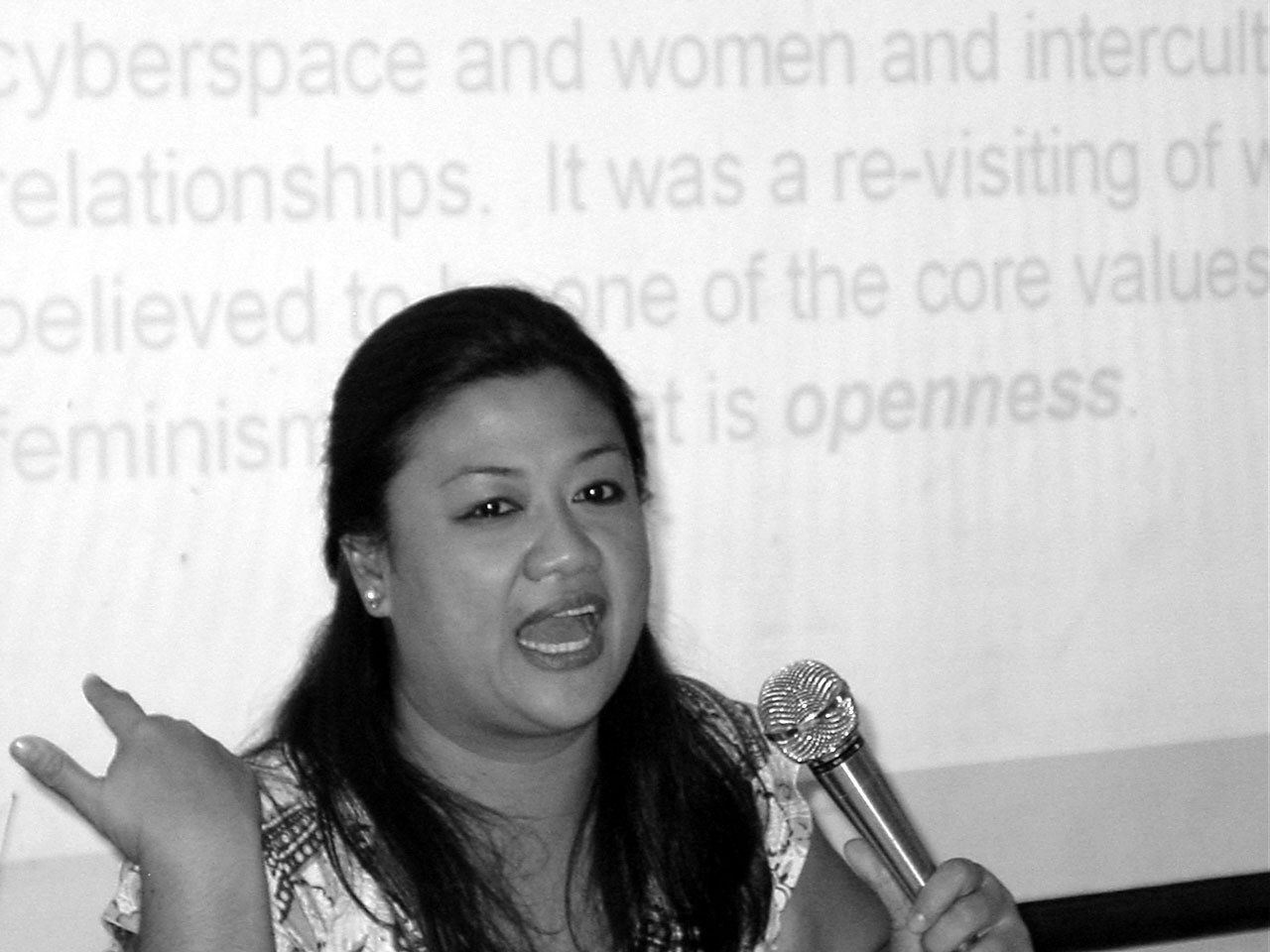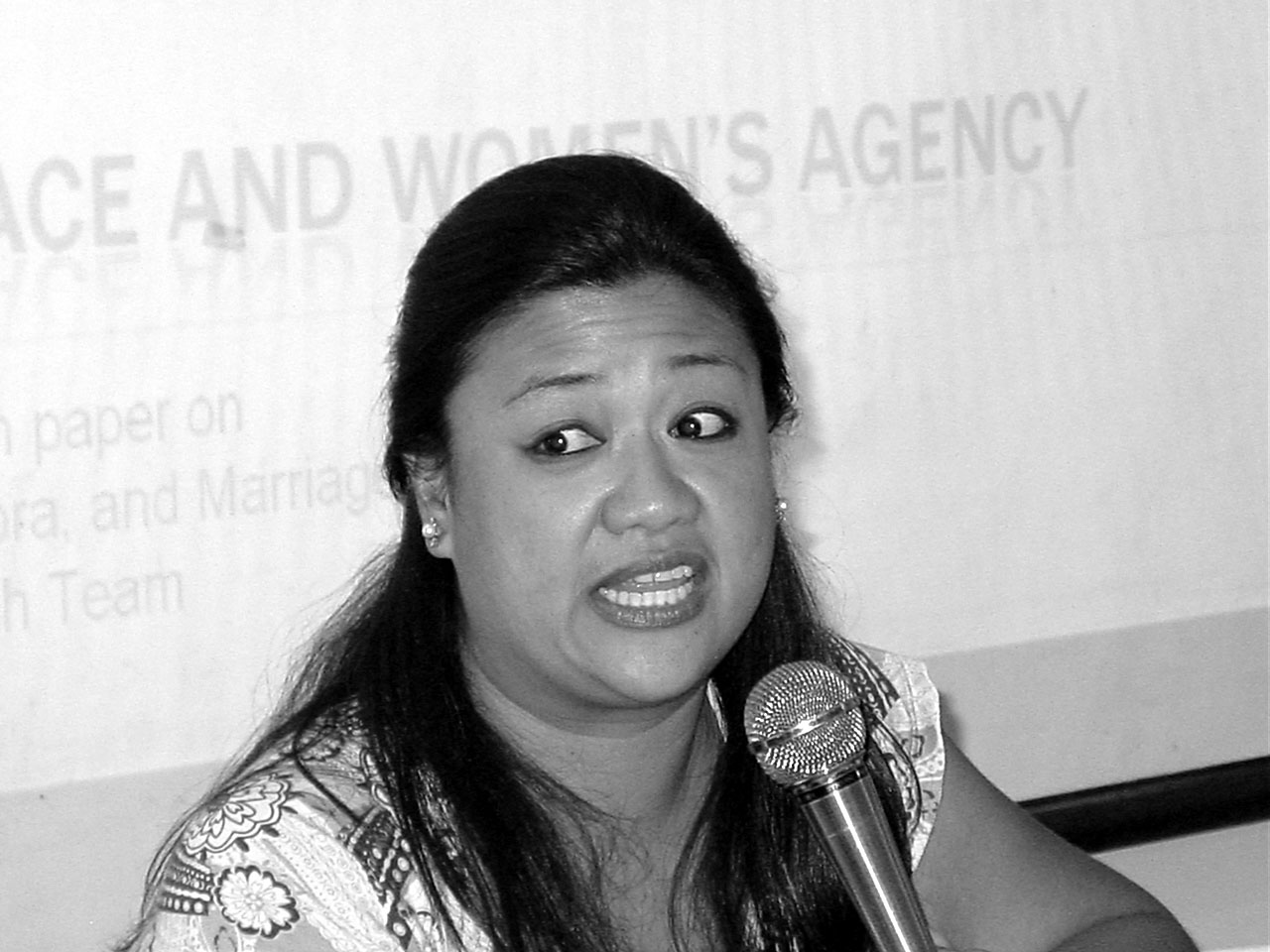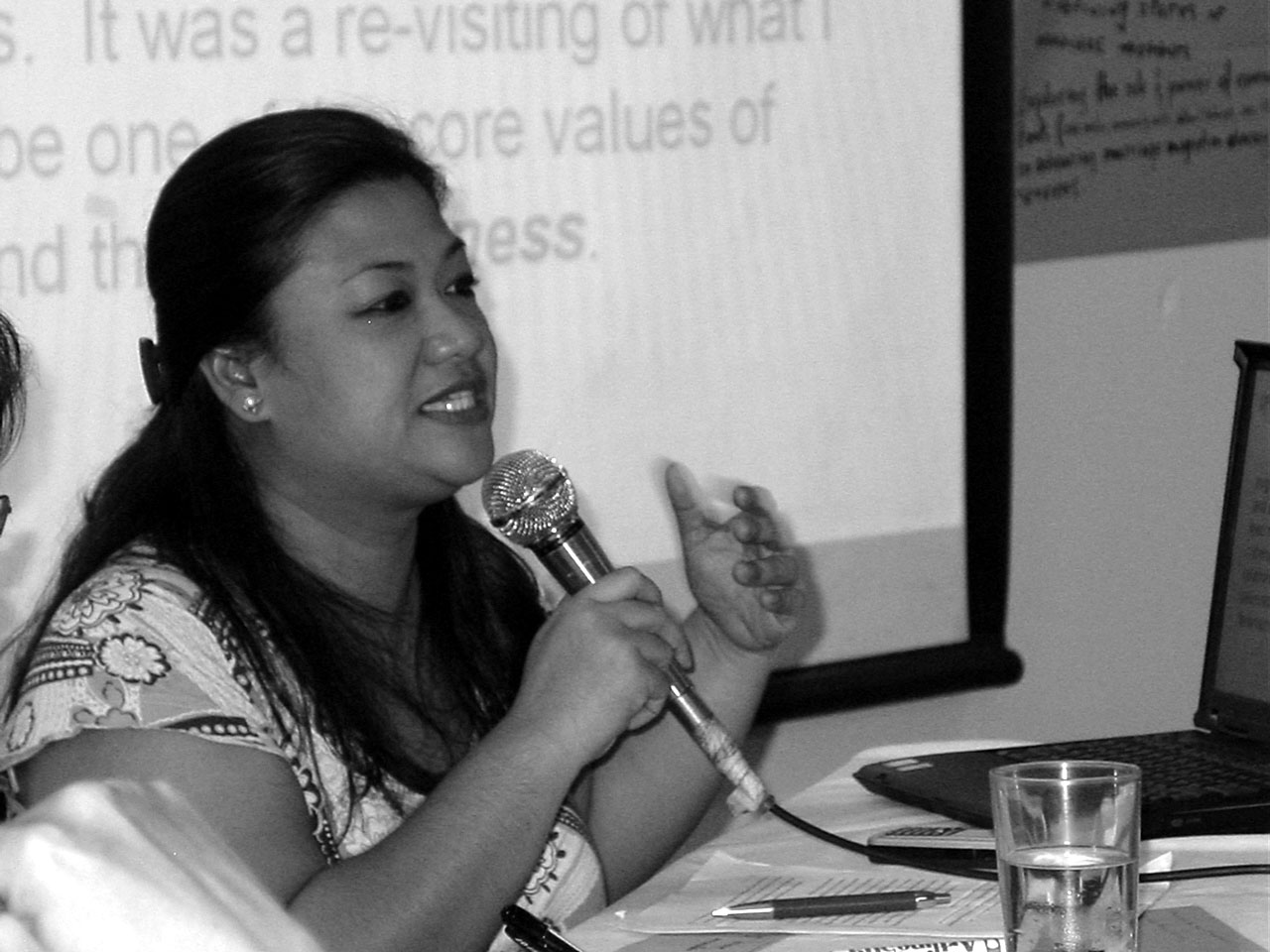The Role of Cyberspace in Marriage Migration in Asia: Claiming Spaces for Intervention
The Pre-Research Process: Opportunity for Self- reflexivity
For the longest time, I have considered my knowledge about cyberspace very limited. I also had strong opinions against developing relationships online because I had a friend who had her heart broken too many times by online relationships.
The pre-research process on marriage-migration in Asia was not only a learning experience but has also led me to a process of self-reflexivity. This process of questioning my biases against cyberspace and women and intercultural relationships was a way for me to re- visit what I believed to be one of the core values of feminism, and that is openness. In gathering related literature on this phenomenon, interviews with Filipino women who have experienced marrying foreign men and their various reasons for doing so, talking to women who are savvy users of information and communications technologies (ICTs), and also hearing from women who are more into online dating than going to bars to meet people, all these conversations have challenged my biases. It opened my mind to various ways relationships are formed, the reasons and circumstances of marriage in different cultures.
Being part of this research team that looked into marriage migration in Asia has made me understand, expand my knowledge, and provide an opportunity to appreciate cyberspace—understand how it participates in facilitating “services” for the sex industry on the one hand, and how, on the other hand, it builds and sustains relationships in the context of migration and at the same time provides social movements with a space for intervention.
Defining Terms
Two terms need to be defined in this discussion paper: cyberspace and women’s agency. Webopedia offers a simple definition of cyberspace or the de facto synonym for the internet, and what we would later call the World Wide Web in the 1990s, especially within the activist and academic circles. Cyberspace is also used a metaphor for describing the non-physical terrain created by computer systems. Online systems, for example, create space within which people can communicate with one another (via e-mail), do research, or simply window shop.
Like physical space, it contains objects (files, mail messages, graphics etc.) and different modes of transportation and delivery. To explore cyberspace does not require any physical movement other than typing on the keyboard or moving a mouse. Users experience a virtual reality, where they are presented with visual, auditory, and even tactile feedback that makes cyberspace feel very real.
Another important term is women’s agency. In the book Women’s Agency in Classical Economic Thought: Adam Smith, Harriet Taylor Mill, and J.S. Mill, by Ronald G. Bodkin (1999), women’s agency is defined as the capacity of a female economic agent for rational decision making. However, the pre-research phase of literature review and two roundtable discussions on marriage migration have also expanded its use to include women’s experiences of making the most of the situation, including:
- her ability to rise above the pressing situation;
- participation in the community;
- assertion of identity;
- how she continues to survive and make changes for herself and her immediate environment and community.
Developing a discussion paper on omen’s agency and cyberspace has proven to be very challenging. More so because cyberspace and the development of ICTs are predominantly perceived in ter ms of their swift facilitation of the sex industry business, commodification and sexualisation of women, and the ease of movement in the context of human trafficking. Such are certainly real and long standing concerns that need to be addressed.
Various Views of Women and Cyberspace
1. Women as Victims: The Commodification of Women in Cyberspace
...cyberspace and the development of ICTs are predominantly perceived in terms of their swift facilitation of the sex industry business, commodification and sexualisation of women, and the ease of movement in the context of human trafficking.
The impact of information technology on gender issues with specific focus on trafficking is seen as the most “sinister aspects of information technology, especially the internet,” according to the Gender, Information Technology, and Developing Countries publication of LearnLink, a project of the Human Capacity Development Centre of USAID. This publication identifies two main problems to ICT development: 1) amount of sexually explicit material and 2) the ease of access to it. “Sex” is identified as the most common word search performed on any search engine. Recently, the internet has become the most effective tool in the prostitution of women. The women are tricked or forced into performing sex acts for digital photos that appear on globally accessible web sites. The Internet offers several ways to sell sex and allows global sex syndicates to recruit women from all over the globe, all of which contribute to the “globalisation of the sex trade.”
Other articles look into how the Asian “Oriental” woman is sexualised. Actual texts of the men’s experiences and views of Asian women in sex tours, or guides to adult travel are cited. Texts mentioned may be too graphic to quote but suffice it to say that the availability of experiences shared online is only one of the ways sex and the Asian “Oriental” Woman continue to be marketed. These are examples of how the sex industry has taken advantage of almost all ICT development to enhance its business. In fact, the sex industry is identified as one of the top five that invest in state of the art computer equipment, buy the fastest and most expensive phone lines that transmit high resolution images—all of which makes the sex tour experience as real as it can get. Available literature points to the advancement in internet technology as contributing to the trafficking of women and children in both the physical and virtual form, and stresses this as the most sinister aspect of the Internet and ICTs.

 2. Women as Savvy Users
2. Women as Savvy Users
The participation of Isis International-Manila in this collaborative project with the Asian Regional Exchange for New Alternatives (ARENA) consists in looking at the role of cyberspace in the marriage migration process. Although this was not a pronounced area during the interviews done with women who are married or have attempted to marry foreign men, we felt that it was an area that could still be probed. Consultations have also led us to conversations with women who urged us not only to look into women as subjects or commodities in cyberspace, but also to look at the experiences of women who possess technological know how and actively use the internet. A number of women in the Isis staff and circle are into website development, blog ging, and even podcasting. The podcasts done by the Isis women during the ASEAN Civil Society Conference in December 2006, and during the Feminist Dialogues in January 2007, served to share news reports in the form of audio files that may be downloaded in the website. More and more women are also into blogging. Blogs are often used to provide commentary on news or on a particular subject, or serve as online diaries, in the sense that it provides a venue to make public one’s most private and intimate thoughts. Although most blogs are primarily textual according to Wikipedia, there are also other forms of blogs that focus on art, photos, sketches, videos, music, and podcasting—which form part of the wider network of social media.
In 1996, a book entitled Wired_Women: Gender and New Realities in Cyberspace tried to document women’s experiences and knowledge of the net. It was a space where women could express what they wanted: community, infor mation, connection, illuminating the many routes women are taking in cyberspace. In this book, the contributors explored various topics and experiences, including email courtship, gender attitudes, overcoming macho stereotypes, the fine line between freedom of speech and harassment, virtual sex, or reflections on whether gender is indeed meaningless online. Although the book privileges the experiences of western women, it nevertheless shares ways on how women can stake their claim over cyberspace.
3. Cyberspace both Empowers and Disempowers Women
The Role of Cyberspace in the Marriage Migration Process
As in cyberspace and women’s experiences of it, there are various ways of viewing cyberspace and its role in marriage migration. The Isis study on the most effective tools used by women shows there are certain premises and assumptions to our understanding of ICTs and cyberspace:
- Social divides or inequalities (e.g., inequities by class, gender, race, and religion) pre-exist the digital divide. Women’s representation vis-a-vis the Western Male Gaze pre-dates the development of the internet as the new tool where these images are shared.
- ICT development is market-driven. It has been used by the mail-order-bride industry to “improve” business. The advertising line, “Exotic Love at your fingertips” implies the speed with which women are made available to prospective husbands.
- The use and development of ICTs take place in unique cultural, political, and economic contexts. As a tool for communication and information, ICT can operate both at a level of “exploitation of women,” and also as a tool to mediate women’s agency.
- The value of ICT is in its utility or non-utility. The discussion will be looking at ICTs from both sides, in how it facilitates human trafficking while simultaneously offering areas for development organisations to share their advocacies.
Commodification of Women in Intermarriage Websites
The most popular discourse on cyberspace and marriage migration is that of commodification of women. This is something the Philippine Research team can attest to. In our search for relevant articles, for example, an article reviewed for the last writeshop activity was entitled Exotic Love at your Fingertips: Intermarriage Websites, Gendered Representation, and the Transnational Migration of Filipino and Thai Women (Angeles and Sunanta, 1999). In their analysis of six intermarriage websites, the authors stressed how the new digital technologies have transformed the mail-order bride business and facilitated the commodification of women in the Third World. The amazing speed with which cross-border marriages are realised and imagined, aptly described as marriage “at your fingertips,” represents hyper speed. This also points to the following:
The use and development of ICTs take place in unique cultural, political, and economic contexts. As a tool for communication and information, ICT can operate both at a level of “exploitation of women,” and also as a tool to mediate women’s agency.
- Women who go for intermarriage websites see this as an opportunity for upward mobility.
- Women’s packaging as brides in these websites are similar to their portrayal in colorful printed catalogues. Women are still viewed through the colonial male gaze and subjected to gendered representations. For example, Thai Women are portrayed as sex workers and Filipina women as helpers and wives.
- Third world women are portrayed as the Other, in comparison to Western Women. Western women are depicted as domineering and nagging while Asian women are presented as passive, traditional, family oriented, and feminine.
- Brokered marriages between 1st world men and 3rd world women account for transnational migration.
- In Cyberspace, there is a thin line between the mediated and the virtual world. In the article “Exotic Love at Your Fingertips,” the authors talks about intermarriage websites as blurring the distinction of the virtual vs. the real world, as the technology has made the experience and the access of these women very real through visual and auditory effects.
- The women’s representation as weak and submissive sometimes also contributes to their experience of violence in marriage. Men expect to get the package of the traditional wife, and they do not appreciate the fact that these women are able to exercise their agency and assert themselves. This then leads to domestic violence.
Can Cyberspace offer possible spaces for intervention? It seeks to pose this question as it explores cyberspace as a site for education, and space where information and resources on marriage migration can be shared among feminists, activists, advocates and the academe.
Although the research team recognises cyberspace’s contribution to making the sex industry on the web more lucrative, and facilitating the process of marriage migration, it would like to pose other ways of viewing it. So the question is raised: Can cyberspace offer possible spaces for intervention? It seeks to pose this question as it explores cyberspace as a site for education, and space where information and resources on marriage migration can be shared among feminists, activists, advocates and the academe.
Cyberspace As Space for Intervention
The short section on Impact of Information Technology on Gender Issues: Trafficking also ends on a positive note on the use of ICTs. The section recognises the role of cyberspace and ICTs in the globalisation of the sex trade, but also sees it as the same space used by anti-trafficking activists in Brazil and elsewhere to warn women about sex slavery. Several organisations operate a website that hosts electronic newsletters, Internet chat rooms that combat trafficking in women and girls. Thus, cyberspace and other ICTs are used by both profiteers from the sex industry and those who combat them.
In the Preface of Women@Internet, Wendy Harcourt summarises the four feminist challenges in the virtual world as well as the context needed for such work to exist. Harcourt summarises the feminist challenges in the web world (cyberspace): 1) women must not be left behind in the gap between those who have access to the new information technologies, and those that do not; 2) women should be active agents in ensuring that the potential of new information technologies are directed towards enhancing human well-being rather than strengthening existing power monopolies; 3) establishing partnerships with men in developing new concepts and cyberspace; 4) the possibilities that new forms of communication and expression should be navigated for our place-based knowledge and action.
Harcourt, also talks about the context for which these challenges can be met; this context values democracy and human rights, but most importantly it recognises the freedom and braveness required by creativity, that facilitates the creation of new values and institutions.
It is true that cyberspace is host to numerous intermarriage websites and the sex industry, but it is also the space that we occupy to advertise our organisations and services, promote our advocacies and positions on social issues, organise protests and mass actions. It is a powerful site for disseminating information, for knowledge sharing, and for social movement building.
References
Angeles, L. and Sirijit, S. (2007). “Exotic love at your fingertips: Intermarriage websites, gendered representations and the transnational migration of Filipino and Thai women.” Kasarinlan: Philippine Journal of Third World Studies, 22 (1), 3-31.
Cherny, L. and Weise, E. R. (eds.). (1996). Wired_Women: Gender and new realities in cyberspace. Seattle, Washington. Seal Press.
Hafkin, N. and Taggart, N. (2001). Gender, information technlogy, and developing countries: An analytic study. Office for Women in Development Bureau for Global Programs, Field Support and, Research (USAID).
Harcourt, W. (ed.). (1999). Women@Internet (Creating New Cultures in Cyberspace). Zed Books Ltd.





 The
The 
 Isis Resource Center holds one of the largest feminist collections of materials in the Global South. With 40 years of publication experience, Isis holds a vast collection.
Isis Resource Center holds one of the largest feminist collections of materials in the Global South. With 40 years of publication experience, Isis holds a vast collection.